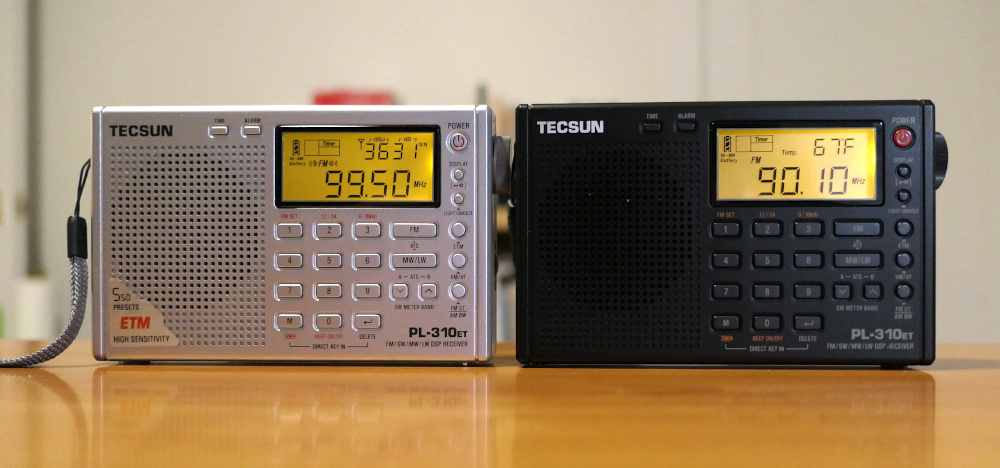
Introduction
One of Tecsun's earliest DSP models was the PL-310 AM/FM/longwave/shortwave radio. Even though it featured the kind of performance that could have been previously obtained only from more expensive receivers, there were some issues, particularly with a "soft muting" function that tended to interfere with the reception of very weak signals.
For most listeners, that wouldn't have been an issue, but hobbyists who seek out weak signals were very frustrated by the "soft muting" issue.
The PL-310 also came out before Tecsun began featuring Easy Tuning Mode (ETM), a second bank of station memories that could be very handy when traveling to other locations, enabling a quick scan of signals available without disturbing pre-existing memory presets.
In 2013, Tecsun added ETM to the PL-310 along with other improvements, renamed the model as the PL-310ET. Earlier, before buying my Tecsun PL-380, I considered buying the PL-310, but the PL-310 did not have ETM, so I bought the PL-380. With the updated PL-310ET, I was curious to see how the updated model compared with the PL-380, as well as with the newly released (in 2013) CC Skywave travel radio.
Both the PL-310ET and the PL-380 were available in three colors: silver, gray, or black. The first PL-310ET that I bought was black. Later, because I really like the look of silver-colored radios, I bought one in silver. Both are pictured at top of this page. The two radios perform similarly, though they were purchased years apart. When I took new photos for this review in 2025, I used the silver radio for most of the photos because the details in those pictures were easier to see.
PL-310ET performance and features
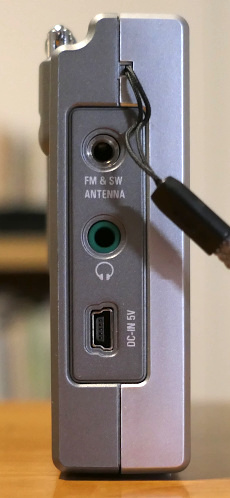
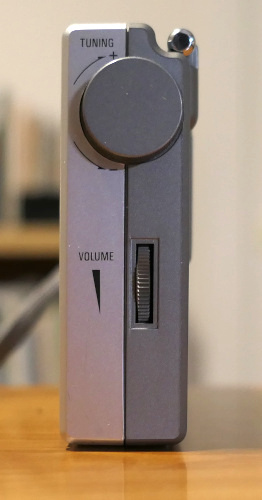
There are two noticeable differences between the PL-310ET and the PL-380 aside from the layout of the buttons on the front panel.
The PL-310ET and has a jack on the left side of the unit (see left) for connecting an external FM or shortwave antenna. On the right side (right), there's a small knob used for tuning between frequencies or memory positions. The PL-380 uses a thumbwheel for the same purpose.
Aside from those two differences, the same functions are available on both models.
Both use a thumbwheel to control speaker or headphone volume. The Tecsun volume controls have been the subject of complaints from some users, since volume levels "jump" from one detent to another, sometimes getting louder than expected.
Both the PL-310ET and the PL-380 require three AA batteries. Each can recharge metal-hydride batteries.
While these two models are very similar, there are a couple more notable differences, in additional to the antenna jack and the tuning knob on the PL-310. The PL-310ET seems to have longer battery life than the PL-380. And I find the PL-310ET's display to be easier to read. The numbers are smaller, but they are bolder. The dial light stays on just a little bit longer for the PL-310ET compared to the PL-380.
As usual for Tecsun radios of this size, the built-in rod antenna is too short for peak FM performance. The length of the antenna should be 30 inches, not the 21 1/2 inches that's the length of the antenna supplied with the radio.
The built-in speaker is small and doesn't sound all that great. This is obviously a radio to use with headphones.
AM reception is compromised somewhat by internally-generated digital noises. This wasn't uncommon among earlier generations of DSP-based radios. This phenomenon did not seem to affect FM reception, though it's possible those noises could have masked very weak signals.
I ordered my PL-310ET through an Amazon reseller for just under $50 (the equivalent of $67 in 2025). Unlike ordering from a Chinese reseller at the time, rechargable batteries weren't included, nor was a box. The manual and a zippered carrying case were included. The carrying case, while not rigid, does have a slight amount of difficulty with the knob that sticks out slightly from the right side of the radio.
You can check out my review of the PL-380 for more details on use of the radio, audio quality, etc. The next section of this review evaluates the PL-310ET in comparison with a similar travel radio, the CC Skywave.
Comparison with the CC Skywave radio (2014)
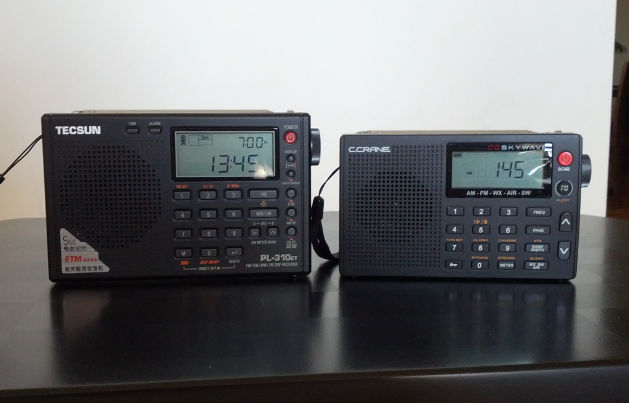
Note: The picture to the left is the only one that has been retained from the original 2014-2015 review.
One more note: This part of the page may look strange if you're viewing it on a mobile phone or on a monitor oriented in portrait mode. I'm sorry for that, but this part of the page was very difficult to lay out correctly and this is the best I can do for now. It looks much better in landscape mode.
C. Crane's release of the CC Skywave radio in the last quarter of 2014 created the opportunity to do a head-to-head comparison of two radios aimed at listeners seeking a high-performing compact radio. Both the CC Skywave and C. Crane's earlier CC Pocket radio seemed to be tailored to the needs of the American market, including coverage of the weather-radio band, used only in North America.
I included the CC Pocket to provide another benchmark for comparison, though I think it competes in a slightly different niche than the other three radios.
During a very windy day at midday on the last week of December 2014 at my location in Oakland, California, I did a head-to-head comparison among the PL-310ET, the PL-380, the CC Skywave, and the CC Pocket. Signals available varied from day to day and sometimes, for the very weakest signals, even in the same hour. Results obtained on another day could have been different. So it's important not to say one radio is much better than the other just because it could pick up one or two more signals.
| Model | AM | FM |
|---|---|---|
| (Available stations) | 47 | 52 |
| CC Pocket | 45 | 50 |
| CC Skywave | 46 | 50 |
| Tecsun PL-310ET | 45 | 51 |
| Tecsun PL-380 | 47 | 52 |
What's notable is how close these radios are in performance. They all could be better on FM with a properly sized antenna, but even then, I believe the improvement would be more noticeable with weak signals becoming stronger, and not with just picking up more stations.
As I observed previously, the AM performance of the CC Skywave was better than the Tecsun radios in a couple of other ways. There were many fewer digital noises, such as beeps or tones, on the CC Skywave. There were a few more on the CC Pocket, but still it was much quieter than the Tecsuns. Audio recovery through the automatic gain control was just a little stronger and more consistent on the CC Skywave and the CC Pocket (second version).
The audio quality of the CC Skywave was just a little better compared to the other radios, both with headphones and through the speaker -- there was a little more bass and a little more presence. The analog volume control also provided better control over listening volume. There wasn't an abrupt jump between levels as there sometimes can be with the Tecsun radios.
Ten years later
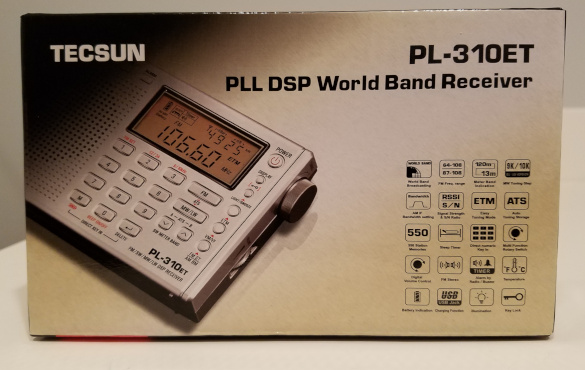
I got the silver PL-310ET in January 2020, just as the Covid-19 pandemic was starting to turn the world upside-down. It wasn't available through Amazon, but it was available through one of the Hong Kong-based resellers on eBay. I bought this second unit from the seller anon-co, which has been a reliable source for radios from China not otherwise available. I didn't expect much difference in performance or behavior between the silver model and the black model and, over a five-year period, I haven't observed any.
The bigger question is how the PL-310ET compares to the "second generation" of DSP-based radios that began coming out around 2022 or 2023. After acquiring the Tecsun PL-320 and Qodosen DX-286 radios in 2023 and 2024, and noting their high level of performance, I decided to do a head-to-head comparison with those radios, and with the Tecsun PL-310ET and PL-380. The comparison was at my location in Denver, Colorado, where I had moved.
I've created a separate page with the details of my comparisons. For this page, I'll just summarize. While differences among the radios were slight, the newer radios, the Tecsun PL-320 and the Qodosen DX-286, performed better than older DSP-based models such as the PL-310ET on both AM and FM. The newer models also suffered less (if at all) from internally-generated digital noises, which were a problem on the PL-310ET as well as the PL-380. Finally, the newer models use either USB micro or USB-C ports. USB-C is more desirable, since it's emerging as the most commonly used port.
That said, the PL-310ET still offers some advantages. Most notably, its use of standard or rechargeable AA batteries means it's easy to travel with. There's no lithium-ion battery such as the newer models use, so it can go into checked luggage. The PL-310ET is a little less complex than the PL-320. Its frequency display is bold and easy to read. Controls work very smoothly. For me, the big downside is the USB "mini" port, which was far more common 15 or 20 years ago than it is now. I have to keep some adapters and extra cables around as a result.
Both of my PL-310ETs have held up well over time. They work as well as they do when I first got them.
Even so, as of the time I revised this review, the PL-310ET had been on offer for at least 12 years. Tecsun does stick with radio models for a long time, even as it introduces new ones. While it appears the PL-310 is no longer available from Amazon, the Chinese eBay resellers still carry them. Tecsun's official site still shows it as well. But that site shows other models not available in the United States, so it's not a guarantee of availability for U.S. buyers.
Even if newer models perform just a little bit better, the PL-310ET remains a worthy contender as a general-purpose radio that travels well, too.